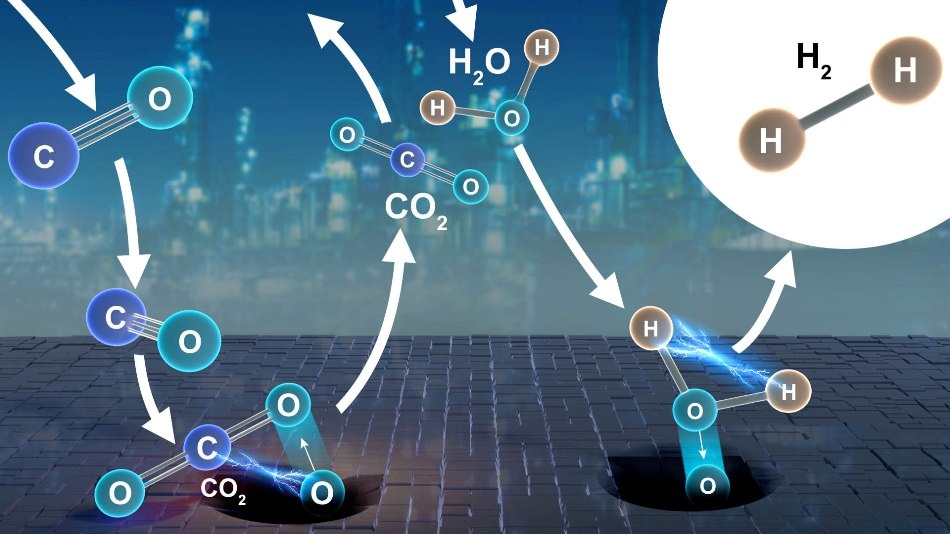Jul 31 2019
Sophisticated characterization techniques, including neutron scattering, have been used by collaborators at the Department of Energy’s Oak Ridge National Laboratory (ORNL) and U.S. universities to examine how the “water-gas shift” reaction purifies and produces hydrogen at industrial scale with the help of a prominent catalyst.
 Collaborators at the Department of Energy’s Oak Ridge National Laboratory and U.S. universities used neutron scattering and other advanced characterization techniques to study how a prominent catalyst enables the “water-gas shift” reaction to purify and generate hydrogen at industrial scale. (Image credit: Oak Ridge National Laboratory)
Collaborators at the Department of Energy’s Oak Ridge National Laboratory and U.S. universities used neutron scattering and other advanced characterization techniques to study how a prominent catalyst enables the “water-gas shift” reaction to purify and generate hydrogen at industrial scale. (Image credit: Oak Ridge National Laboratory)
The results of the study, reported in the Journal of the American Chemical Society, have resolved a long-standing controversy about the reaction mechanism of the catalyst, paving the way to enhance the efficiency and cost of hydrogen production at large scale.
Our work significantly advances fundamental understanding of a complex, industry-critical catalyst that has been difficult to study. Determining how this reaction works at the atomic level enables further efforts to optimize the catalyst for improved performance.
Zili Wu, Chemical Sciences Division, Oak Ridge National Laboratory
Collaborators examined a copper-chromium-iron oxide catalyst (CuCrFeOx) supplied by Lehigh University.
“We already know the existing CuCrFeOx catalyst works, but how it works has been the subject of debate,” stated Felipe Polo-Garzon from ORNL, who worked with Wu on the group’s multimodal method to determine the reaction mechanism of the catalyst.
The aim of the study was to investigate the behavior of the catalyst in real-world settings to find proof of either an associative mechanism or an oxidation-reduction (“redox”). These are two main concepts about the way the CuCrFeOx catalyst works to generate hydrogen.
In a typical redox reaction, reactants produce new substances by exchanging a few of their atoms with the surface of the catalyst. The new substances, in this case, are carbon dioxide and hydrogen. On the other hand, in an associative reaction, the entire reacting molecules attach to the surface of the catalyst in an intermediate step to reach the end products.
Hence, to explicitly demonstrate the workings of the CuCrFeOx catalyst (redox versus associative mechanism), the scientists cast a broad net of computational and experimental techniques.
The results that were obtained indicated the same conclusion—that is, a redox reaction. The catalyst—at extreme temperature conditions—loses its oxygen atoms to make space for water molecules that have a tendency to dissociate and yield pure hydrogen.
“The answer is important because it helps us identify the critical point in the reaction where hydrogen is generated,” Polo-Garzon said.
Several existing catalysts have been produced through trial and error that usually restricts their efficiency. The significant discovery made by the research team can help remove guesswork and inform scientists accurately where to look for opportunities to create a more improve catalyst for producing hydrogen.
Although hydrogen is the most abundantly available element on Earth, it does not materialize naturally in the pure form required by industries for metal treatment, food processing, ammonia production for fertilizers, oil refining, and other extensive applications.
Hydrogen supply in most of the globe is generated through steam methane reforming—which involves the conversion of natural gas into a hydrogen mixture that is eventually refined through water-gas shift catalysis to produce pure hydrogen.
There are a number of factors that restrict the interpretation of what actually makes hydrogen production feasible during the water-gas shift reaction. Since the CuCrFeOx catalyst reconstructs at the time of the operation, the fresh and spent versions are varied, making it specifically difficult to define the material.
Earlier, information about the way the surface chemistry alters during reaction conditions was not taken into consideration, which added to the complexity.
Another barrier is the color of the compound. The black catalyst hinders traditional methods, including optical spectroscopy, that depend on light to acquire data, because the sample is extremely dark to “see” effectively.
At ORNL’s Spallation Neutron Source, a DOE Office of Science User Facility, neutron vibrational spectroscopy experiments were carried out on the VISION beamline that helped in resolving some of the difficulties of examining the CuCrFeOx catalyst.
Since the interaction between neutrons and samples is different from that of light, neutrons can complement the data acquired from optical methods. In addition, they are suitable for tracking hydrogen, which is not easy to identify with other experimental techniques due to the low atomic weight of the element.
According to Polo-Garzon, the payoff was two-fold.
Neutrons gave us a critical piece of the puzzle to disprove the associative mechanism, showing us that no relevant intermediate was present on the catalyst’s surface. We also observed something that has not previously been detected on the catalyst’s surface—hydrides.
Felipe Polo-Garzon, Chemical Sciences Division, Oak Ridge National Laboratory
Hydrides are actually surface species that have an important role to play in hydrogen-based reactions but cannot be easily detected in mixed-metal materials, such as CuCrFeOx.
Apart from neutron experiments, the scientists carried out isotopic transient kinetic analysis at ORNL, and temperature-programmed surface reaction characterization and infrared spectroscopy at the Center for Nanophase Materials Sciences, a DOE Office of Science User Facility; and also near-ambient pressure X-ray photoelectron spectroscopy at the University of Kansas.
They also performed density functional theory compactions at the University of California, Riverside, which utilized resources of the National Energy Research Scientific Computing Center—a DOE Office of Science User Facility.
“You need more than one approach to gather and interpret all of the information needed to build the whole story,” stated Polo-Garzon. “Our collaboration highlights the success of a multimodal approach to yield fundamental breakthroughs.”
The journal article is titled, “Elucidation of the Reaction Mechanism for High-Temperature Water Gas Shift over an Industrial-Type Copper–Chromium–Iron Oxide Catalyst.”
The study was supported by the DOE Office of Science.